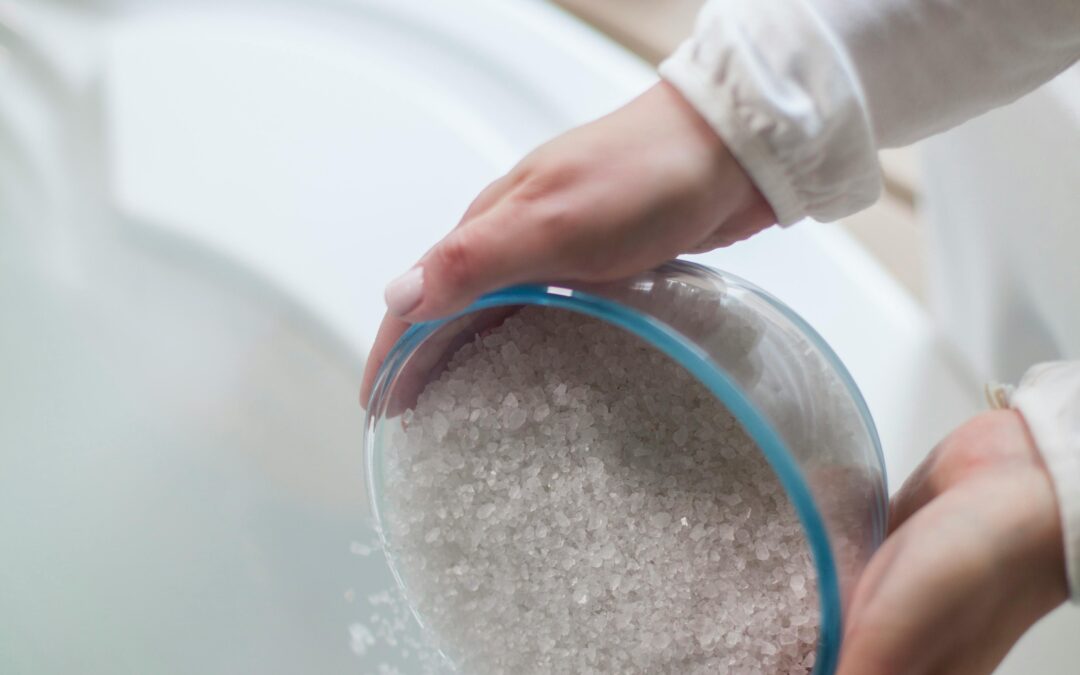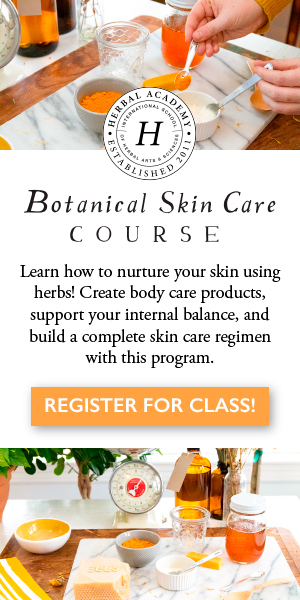
by Leslie Moldenauer | | Essential Oils
Introduction: Why Essential Oil Bath Safety Matters
Adding essential oils to your bath sounds relaxing and therapeutic, but without proper dispersal, it can lead to skin irritation or worse. This article breaks down the science behind essential oil solubility and how to ensure your bath is both safe and effective.
Understanding Molecules: Polar, Non-Polar, and Ionic
Chemistry might not have been everyone’s favorite subject, but understanding a few key concepts is crucial for safe essential oil use in baths.
- Polar Molecules: Have slightly positive and negative charges (e.g., water).
- Ionic Substances: Act like extremely polar molecules (e.g., salts, baking soda).
- Non-Polar Molecules: Do not have charged ends (e.g., essential oils).
Rule of Thumb: Like dissolves like. Polar dissolves polar, and non-polar dissolves non-polar. You can easily see now that taking an essential oil which is non-polar and adding it to water, or even Epsom salts is not safe or effective.
Why Essential Oils and Water Don’t Mix
Water (polar) and essential oils (non-polar) are fundamentally different. When you add essential oils directly to water—or even mix them with salts or baking soda—they’ll float on the surface.
✅ What happens when you add essential oils to water?
- Oils float on top.
- Skin contact can cause irritation, rashes, or sensitization.
- Warm water won’t change this behavior.
- Vigorously swishing won’t change this behavior.
Common Myths About Essential Oils in Baths (Busted!)
Myth 1: “Baking soda will absorb essential oils and disperse them.”
- ❌ False. Baking soda is ionic and won’t properly disperse non-polar essential oils.
Myth 2: “Warm water helps essential oils mix with salts or baking soda.”
- ❌ False. While salts dissolve faster in warm water, essential oils will still float on top.
The Right Way to Use Essential Oils in Your Bath
To safely disperse essential oils in a bath:
- Use an emulsifier like carrier oil (e.g., jojoba oil or coconut oil).
- Blend essential oils with a solubilizer specifically designed for baths.
- Follow recommended dilution guidelines for essential oils in bath products.
Pro Tip: Avoid adding essential oils directly to your bath water, no matter how tempting it might seem.
Final Thoughts: Safety First for a Blissful Bath Experience
Understanding the chemistry of essential oils ensures you can enjoy their benefits without risking skin irritation or discomfort. Always use proper dispersants and respect the science behind the soak.
Enjoy your aromatic bath safely and blissfully! 🫧✨
Witch Hazel (Hamamelis virginiana)-Uses and Limitations

by Leslie Moldenauer | | Essential Oils, Herbs
Winter wellness is more than bundling up in cozy blankets and sipping on warm drinks, although avoiding crowded places is a solid start. Our immune systems are tested as the colder months arrive, and stress levels can climb with holiday demands. To navigate this season with vibrant health, it’s essential to focus on quality nutrition, boosting immunity and finding effective ways to relieve stress.
My recent experience with norovirus in our household brought this message home. It began with my youngest, who experienced the worst symptoms despite being a healthy eater, albeit one who enjoys carbs and limited sugars. In contrast, my eldest child and I, who have been experimenting with the carnivore diet—emphasizing quality organic, grass-fed, and grass-finished ingredients—experienced only mild stomach discomfort. This personal observation reinforced a theory I and many others have heard and thought before: there isn’t a flu season; there’s an increased sugar season. Viruses thrive on sugar, a concept supported by research from The University of Copenhagen showing us that bacteria and viruses infect our cells through sugars (Cao et al., 2021). Observing this theory play out in our lives was eye-opening.
Diet: Your First Line of Defense
Mindful Nutrition: Tackling Sugar During the Holidays
The holidays are a season of joy, connection, and indulgence. But let’s face it—it’s also the time when sugary treats seem to be everywhere! The temptation to indulge can be overwhelming, from cookies and candy canes to festive cocktails and pies. While enjoying your favorite holiday treats is okay, moderation is the key to maintaining your wellness throughout the winter.
Tips for Moderation
- Portion Control: Instead of loading your plate with every dessert on the table, pick one or two that you truly enjoy. Savor each bite to make it more satisfying.
- Balance It Out: Pair sugary treats with a source of protein or healthy fats to slow the release of sugar into your bloodstream, helping to avoid that dreaded sugar crash.
- Hydrate: Often, we confuse dehydration with hunger or cravings. Drinking water throughout the day can help curb the urge to overindulge.
- Plan Ahead: If you know you’ll be attending a party with a lot of sweets, eat a balanced meal beforehand to prevent overindulging on an empty stomach.
What to Do if You’ve Overindulged
Even with the best intentions, going overboard at a holiday party is easy. If you find yourself in a sugar overload, don’t panic. Here are some steps to help your body recover:
- Hydrate with Lemon Water: Drinking water with a squeeze of lemon can help flush excess sugar from your system while supporting your liver and digestion.
- Get Moving: A brisk walk or light movement after eating can help stabilize blood sugar levels and improve digestion.
- Skip Sugary Foods the Next Day: Give your body a break by focusing on whole, nutrient-dense foods like leafy greens, lean proteins, and healthy fats.
- Sip Herbal Tea: Teas like peppermint, dandelion root, or ginger can help soothe digestion and support detoxification.
The Importance of Grace
Above all, remember to be kind to yourself. The holidays are meant to be enjoyed; no indulgence will derail your wellness journey. By being mindful, planning, and supporting your body after indulgence, you can strike the perfect balance between enjoying the season and prioritizing your health.
Herbs for Winter Wellness
Herbs have been used for centuries to combat illness and support the immune system, thanks to their anti-viral, anti-bacterial, and anti-microbial properties. Here are some of the best herbs to include in your winter wellness routine:
- Elderflower and Elderberry: These are excellent for supporting the immune system and fighting off colds. Elderberry, in particular, is a powerful ingredient in syrups that can help shorten the duration of illness.
- Echinacea: Known for its immune-boosting properties, echinacea can be used in teas or tinctures to help ward off colds.
- Ginger: This versatile herb is anti-inflammatory and warming, making it perfect for teas or as an addition to meals.
- Ashwagandha: This adaptogenic herb helps manage stress and supports overall immunity. Use it in tinctures or as a powder added to smoothies.
- Tulsi (Holy Basil): Known as the “elixir of life,” Tulsi is excellent for immune support and stress relief and is commonly consumed as tea or tinctures.
- Oregano: Oil of oregano, not to be confused with essential oil, is a potent anti-microbial and anti-viral remedy. Available in capsules, it can be a powerful tool for maintaining health during the winter. This is a brand that I recommend. (https://amzn.to/3P0tZqy)
- Stinging Nettle: This herb packs a sting while fresh and is very effective when consumed when dried in tea, tincture, or even on top of a salad. It is widely considered one of the most nutrient-dense wild plants rich in vitamins and minerals. You will absorb the goodness of this wild herb better than any pill.
Essential Oils: A Powerful Ally for Winter Wellness
Incorporating essential oils into your winter wellness routine can provide natural, effective support for your respiratory and immune systems. Numerous studies have demonstrated the anti-viral, anti-inflammatory, and immune-boosting properties of essential oils, making them an excellent complement to healthy habits like moderating sugar intake.
For instance, research by Sienkiewicz et al. (2014) highlights how essential oils such as eucalyptus, thyme, and oregano can inhibit viral replication. This is especially beneficial during cold and flu season when respiratory health is a top priority. While sugar can fuel inflammation and weaken your immune system, essential oils work to counteract these effects, offering a holistic way to stay healthy.
Simple and Effective Ways to Use Essential Oils
- Sniffy Stick: A personal inhaler is an easy, portable way to benefit from essential oils throughout your day.
- Diffuser: Add your chosen blend to a diffuser to fill your space with soothing, therapeutic aromas.
- Steam Tent: For deep respiratory support, add 2–3 drops of essential oil to a sink or bowl of hot water. Drape a towel over your head and inhale deeply for several minutes.
These methods not only support your respiratory system but also promote relaxation—something we all need during the often-stressful holiday season.
DIY Winter Wellness Sniffy Stick Blend
Here’s a simple and effective blend you can use to support respiratory health and boost your winter wellness:
- 4 drops Eucalyptus essential oil – Clears congestion and supports the respiratory system.
- 3 drops Thyme essential oil – Known for its anti-viral and immune-boosting properties.
- 2 drops Oregano essential oil – A powerful anti-viral that helps fight off seasonal bugs.
- 1 drop Lemon essential oil – Adds a refreshing note while offering additional immune support.
Instructions:
- Add the essential oils to the wick of a blank sniffy stick (available online or at health stores).
- Insert the wick into the inhaler tube and close it tightly.
- Carry your sniffy stick with you and use it as needed by taking slow, deep inhalations through your nose.
Safety Note
While essential oils can be incredibly beneficial, it’s important to use them safely. Essential oils are highly concentrated, and improper use can cause skin irritation, sensitivity, or adverse effects. To learn more about using essential oils safely, check out my blog on for detailed guidelines on dilution, usage, and selecting high-quality oils.
Wrapping Up Winter Wellness
This winter, prioritize your winter wellness by adopting a nutrient-rich diet, leveraging the power of herbs for immunity, and incorporating essential oil’s antiviral properties into your daily routine. By strategically reducing sugar intake, using herbs and essential oils, and practicing stress relief techniques, you can boost immunity and keep your body strong and resilient. With mindful choices and natural support, you’ll be well-equipped to stay healthy and thrive throughout the season.
- Viruses and Sugar Intake: Research indicates that certain viruses utilize sugars on host cell surfaces to facilitate infection. For instance, the spike protein of SARS-CoV-2 binds to specific sugars to enter cells. This highlights the role of sugars in viral infections.
Science Daily
- Antiviral Properties of Essential Oils: Studies have demonstrated that essential oils, such as those from eucalyptus, thyme, and oregano, exhibit antiviral activities. For example, eucalyptus essential oil has shown effectiveness against various respiratory viruses.
MDPI
Astragalus Root for Immune System Support and Respiratory Ailments

by Leslie Moldenauer | | Body, Essential Oils
Chronic pain can feel all-consuming, whether it’s from a long-term injury, a chronic condition, or an autoimmune issue where pain is a significant symptom. Understanding the difference between chronic and acute pain is crucial, as they require different management approaches. Acute pain is short-term and typically resolves as your body heals. Chronic pain, on the other hand, lingers for months or years, often signaling an underlying issue.
Autoimmune conditions like rheumatoid arthritis or lupus add another layer of complexity, with pain resulting from systemic inflammation that the body can’t quickly resolve. Fortunately, there are ways to manage pain and inflammation holistically.
In this article, we’ll explore 3 ways to lessen inflammation and find relief today using essential oils, anti-inflammatory superfoods, and therapies that can offer relief without relying on over-the-counter (OTC) pills.
-
Utilize Essential Oils to Ease Pain Perception
Chronic pain involves complex signaling between the nervous system and the brain. Essential oils can help disrupt or dull this communication, offering some relief. Here’s how:
Essential Oils for Pain Relief
Lavender Essential Oil
Lavender is one of the most well-known essential oils for its calming properties, but it also plays a significant role in pain management. Research shows that lavender can help reduce pain perception, making it an excellent option for chronic and acute discomfort. In a new study published by Cell Reports, lavender has been shown to have significant antinociception properties (Yang, Yumeng et al. 2024). Antinociception refers to inhibiting the detection of a painful stimulus by nociceptive (pain) neurons. Lavender essential oil works well in blends for headaches, muscle tension, and mild injuries. Lavender’s ability to relax the mind and body enhances its effectiveness in managing pain. To be clear, these findings are based on inhalation alone.
Copaiba Essential Oil
Copaiba is another powerful essential oil when it comes to pain relief. Its primary mechanism is targeting the body’s pain receptors, helping to reduce discomfort from inflammation or injury. Rich in beta-caryophyllene, copaiba is a natural analgesic and anti-inflammatory, making it especially useful for joint pain, muscle soreness, and nerve pain. Copaiba is also gentler on the skin than other essential oils, making it a versatile choice for topical use in pain relief blends. Copaiba is one of the main oils in my Orange Oasis magnesium lotion, a favorite of many to help provide relief and a restful night’s sleep.
Plai Essential Oil
Less commonly known but highly effective, plai essential oil has remarkable pain-relieving properties (Wisuitiprot et al, 2019). It’s part of the ginger family, but unlike ginger, plai is cooling rather than warming, making it an excellent choice for reducing inflammation and soothing sore muscles. Plai is particularly beneficial for joint pain, arthritis, and sports-related injuries. It has been traditionally used in Thai medicine for centuries to relieve aches and pains, and it’s a perfect addition to any pain-relief blend due to its fast-acting, cooling effects.
Tip: Always dilute essential oils in a carrier oil (such as jojoba, apricot, etc.) before applying topically.
-
Fight Inflammation from the Inside Out with Superfoods
Inflammation plays a crucial role in chronic pain, especially for autoimmune conditions. Targeting inflammation can significantly reduce pain levels. Here are some superfoods and functional ingredients to include in your diet:
- Turmeric (with Black Pepper): Curcumin, the active compound in turmeric, is a potent anti-inflammatory. Black pepper contains piperine, which boosts curcumin absorption by 2,000%, making this combo a powerhouse for reducing pain and inflammation. Turmeric is not for everyone; research before adding it to your daily routine.
- Ginger: Ginger has been used for centuries for its anti-inflammatory effects. It inhibits the production of inflammatory molecules in the body, which can help with both acute and chronic pain.
- Functional Mushrooms: Mushrooms like reishi, lion’s mane, and chaga contain anti-inflammatory and immune-regulating compounds. These mushrooms can help reduce systemic inflammation and improve overall immune function. The combination of functional mushrooms, turmeric, and ginger is a powerful trifecta towards lowering inflammation, and it is in my Choco Mushroom Elixir.
- Omega-3 Fatty Acids: Fatty fish like salmon, flaxseeds, and walnuts contain omega-3s, which have been shown to lower inflammation, particularly in conditions like rheumatoid arthritis.
- Green Tea: Green tea is high in antioxidants, notably catechins. It helps reduce inflammation and has been linked to decreased pain in chronic conditions.
Tip: Incorporating these superfoods regularly can provide long-term benefits, but be patient—natural remedies work best when consistently applied.
-
Avoid OTC Pills with Alternative Therapies
While OTC painkillers can offer temporary relief, chronic use can have unwanted side effects. Consider these holistic alternatives:
- Magnesium Lotion: Magnesium helps relax muscles, reduce cramps, and ease inflammation. Topical magnesium lotion allows for fast absorption through the skin, providing localized relief for sore muscles and joints. Find my blends here.
- Cupping Therapy: An ancient practice, cupping increases blood flow to affected areas, helping with muscle tension and pain. This technique is especially useful for back and shoulder pain.
- TENS Unit (Transcutaneous Electrical Nerve Stimulation): TENS therapy uses low-voltage electrical current to disrupt pain signals, providing short-term relief. It’s commonly used for arthritis, fibromyalgia, and back pain.
- Red Light Therapy: This therapy uses low-level wavelengths of red light to reduce inflammation and promote tissue repair. It’s particularly beneficial for joint pain and autoimmune-related inflammation.
- Yoga and Stretching: Gentle movement helps release tension in the body and prevent stiffness, which can contribute to chronic pain. Combined with mindfulness, yoga also lowers pain perception by calming the nervous system.
Tip: Experiment with different therapies to find the best combination for your body.
Conclusion
Chronic pain can feel overwhelming, but by addressing it holistically—through essential oils, anti-inflammatory foods, and alternative therapies—you can start to find relief. Whether you’re dealing with pain from a long-term injury or an autoimmune condition, making small lifestyle changes can have a big impact.
Remember, it’s about building a toolbox of pain management strategies that work for your unique body. You don’t have to rely solely on OTC medications—nature provides many solutions.
Wisuitiprot, V., Bumrungchaichana, W., Kaewtai, N., Rawangking, A., Saiphanit, S., Lasongmuang, K., Meekai, N., & Wisuitiprot, W. (2019). Effectiveness of a Plai Oil Prepared by Thai Traditional Medicine Process in the Treatment of Myofascial Pain Syndrome: A Randomized Placebo Controlled Trial. Journal of Health Science and Medical Research, 37(3), 207-215. doi:http://dx.doi.org/10.31584/jhsmr.201954
Yang, Yumeng et al. (2024). A Neural circuit for lavender-essential -oil-induced antinociception. Cell Reports Volume 43, Issue 10, 114800
My Top 20 Educational Essential Oil Blogs

by Leslie Moldenauer | | Essential Oils, Herbs
Navigating Hormonal Imbalances: A Holistic Approach to Perimenopause, Thyroid, and Adrenal Health
Perimenopause, thyroid dysfunction, and adrenal issues are interconnected conditions that can significantly impact overall health and well-being. This article explores the intricate relationships between these conditions and offers insights into holistic strategies for managing symptoms and promoting hormonal balance.
Understanding Perimenopause, Thyroid, and Adrenal Issues
Perimenopause marks the transitional period leading up to menopause, characterized by a decline in estrogen production. This hormonal shift can result in symptoms such as hot flashes, mood swings, and irregular periods. Concurrently, hypothyroidism, an underactive thyroid condition, can cause fatigue, weight gain, and hair loss. According to Patil (2023), approximately 5 out of 100 Americans aged 12 and older have hypothyroidism, though many cases are mild and go undiagnosed.
Adrenal dysfunction, often a consequence of prolonged stress, can lead to exhaustion, anxiety, and disrupted sleep patterns. The shared link among these conditions is hormonal imbalance and stress. Estrogen, thyroid hormones, and cortisol (the stress hormone produced by the adrenal glands) interact intricately, potentially leading to a cascade of symptoms and challenges.
Common Symptoms and Overlaps
Thyroid, adrenal, and hormonal issues often share overlapping symptoms, making diagnosis and treatment complex. Common symptoms include:
- Fatigue
- Weight gain or difficulty losing weight
- Mood swings and anxiety
- Irregular menstrual cycles
- Sleep disturbances
- Hair loss
- Dry skin
- Digestive issues
Identifying the root cause of these symptoms requires comprehensive testing and evaluation.
The Pituitary Gland and Its Role
The pituitary gland, known as the “master gland,” regulates various endocrine functions. Located at the brain’s base, it secretes hormones that control other glands throughout the body. A sluggish or congested pituitary gland can disrupt hormonal balance, leading to adrenal insufficiency, thyroid dysfunction, and reproductive issues.
Detoxifying the head region, where the pituitary gland resides, is crucial for restoring its function. Raw enzymes, which aid in detoxification, can help alleviate the burden on the pituitary gland and support hormonal regulation.
The HPA Axis (hypothalamic-pituitary-adrenal) Perimenopause Thyroid Adrenal Connection
The hypothalamic-pituitary-adrenal (HPA) axis is a critical feedback loop that regulates the body’s stress response and maintains hormonal balance. It begins in the hypothalamus, which releases corticotropin-releasing hormone (CRH) in response to stress. CRH signals the pituitary gland to release adrenocorticotropic hormone (ACTH), prompting the adrenal glands to produce cortisol. Once cortisol levels reach a threshold, they signal the hypothalamus and pituitary gland to inhibit further CRH and ACTH release, thus maintaining hormonal equilibrium (By et al., 2023).
Holistic Health Practices for Hormonal Balance
Detoxification: Focus on dietary detoxification by eliminating dairy, meat, and grains, and incorporating raw enzymes and a quality mushroom complex. Mental and emotional detoxification is also vital, removing external toxicities wherever possible and bringing in positive influences.
Herbal Support: Adaptogenic herbs like ashwagandha, rhodiola, and holy basil can modulate stress responses, support adrenal function, and promote hormonal balance. These can be incorporated into daily routines through teas or tinctures.
Nutritional Healing: Prioritize whole, nutrient-dense foods rich in vitamins, minerals, and antioxidants. Foods like fruits, non-starchy vegetables, and fermented foods support thyroid function and ease hormonal fluctuations.
Mind-Body Practices: Cultivate mindfulness through meditation, yoga, and deep breathing exercises to reduce stress levels and promote emotional well-being. Practices like the 4-7-8 breath can be particularly effective (Bulzoni, 2023).
Nourishing Recipes
Adaptogenic Smoothie Bowl: Blend a cup of organic mixed berries, a scoop of protein powder (optional), a tablespoon of almond butter, a teaspoon of ashwagandha powder, and a splash of coconut or flax milk until smooth. Top with hemp or chia seeds for a satisfying and hormone-balancing breakfast.
Thyroid-Boosting Quinoa Salad: Cook quinoa and let cool. Combine with diced cucumber, cherry tomatoes, chopped kale, cooked chickpeas, and dairy-free crumbled feta cheese. Dress with olive oil, lemon juice, minced garlic, and dried oregano.
Conclusion
Navigating the complexities of perimenopause, thyroid, and adrenal health requires a holistic approach. By focusing on detoxification, herbal support, nutritional healing, and mind-body practices, individuals can achieve greater overall well-being and hormonal balance.
References
- Bulzoni, S. (2023, March 21). Video: Breathing exercises: 4-7-8 breath. DrWeil.com. https://www.drweil.com/videos-features/videos/breathing-exercises-4-7-8-breath/
- By, Guy-Evans, O., on, U., & 26, O. (2023, October 26). Hypothalamic-pituitary-adrenal (HPA) axis. Simply Psychology. https://www.simplypsychology.org/hypothalamic-pituitary-adrenal-axis.html
- Patil, N. (2023, August 8). Hypothyroidism. StatPearls [Internet]. https://www.ncbi.nlm.nih.gov/books/NBK519536/
_______________
Now, for those seeking additional support on their hormone-balancing journey, I’d like to introduce my own hormone balancing tincture. Crafted with care and infused with the power of nature, this tincture features a blend of red clover, hibiscus, red raspberry, and chaste tree—herbs known for their ability to support hormonal balance and ease symptoms associated with perimenopause and menopause. Please red further to see if this blend is right for you.
Article: https://www.mymenopausetransformation.com/hot-flashes-flushes/plant-phytoestrogens-should-you-have-them-for-your-menopause-symptoms
Article: https://www.livestrong.com/article/544564-hibiscus-tea-and-estrogen/
Article: https://www.bbcgoodfood.com/howto/guide/top-9-health-benefits-of-raspberry-leaf-tea
Article: https://www.healthline.com/nutrition/vitex
If you feel called to explore this natural approach to hormonal health, I invite you to visit my Shopify store to learn more and purchase your bottle of hormone-supportive tincture. May it serve as a gentle ally on your path to wellness.

Adaptogenic blends are easily available online. These blend(s) are among my recommendations. I have very strict guidelines on companies I purchase from and net amounts of an ingredient to avoid mega dosing (affiliate links).
Gentle thyroid support: https://amzn.to/4a0s8Kd
Gentle adrenal support: https://amzn.to/3QlBzgF
Here’s to honoring our bodies, embracing our journeys, and finding beauty in the ebb and flow of hormonal shifts. We are resilient, we are empowered, and we are worthy of vibrant health and well-being.
Blessings, Leslie
https://lifeholistically.com/crippling-exhaustion-not-so-uncommon-anymore/

by Leslie Moldenauer | | Body, Essential Oils, Uncategorized
Reclaiming balance and joy through nurturing the feminine essence is a transformative journey that many women embark on in today’s fast-paced world. In this exploration of the delicate interplay between feminine and masculine energies, we delve into the reasons behind widespread burnout and offer practical insights.
Discover actionable exercises, journaling prompts, and self-care practices to guide women back to their authentic selves. Learn how incorporating products like magnesium lotion can enhance this journey, providing a holistic approach to well-being and reclaiming the beauty of the feminine spirit.
Life Can be a Blur
In our fast-paced world, where the demands of daily life often leave us feeling drained and overwhelmed, the delicate balance between feminine and masculine energies can be easily disrupted as women wear many hats and take on all.the.things!
This is not about boys not crying or girls not playing in the dirt, both of which are BS.
Modern society often celebrates qualities associated with masculine energy, such as productivity, competition, and achievement, while undervaluing feminine energy’s nurturing, intuitive, and creative aspects. Consequently, many of us are caught up in a perpetual cycle of burnout as we strive to meet unrealistic expectations, neglecting our need for rest and self-care.
We all have both energies within us, and it is in that balance that we feel at peace. That balance does look different for everyone, as we are all unique and beautiful beings. For women, being out of balance with these energies may make you feel like things are out of your control, and externals constantly force you to prioritize work over your self-care.
Did that hit hard?
Are you guilty of saying to yourself..” After xyz, I will slow down?”
Do you feel responsible for others’ happiness or healing?
Have you tackled your to-do list/priorities with gusto (adrenaline) and then felt exhausted afterward, possibly feeling guilty for taking that rest? We are in an era perpetually ruled by the masculine. Do more, work harder, and fix the world’s (friends/family/coworkers) problems.
I am NOT saying women should not hold power or have leadership roles. We clearly can do anything we set our minds to. Embracing the essence of femininity involves integrating qualities such as receptivity, yielding, flow, and embracing cyclical patterns. It calls for a spirit of collaboration and the willingness to acknowledge and embrace the depths of the unknown.
When to ask for help. When to rest. When to surrender. Balance is only possible, and the result will eventually be some form of burnout.
This article explores the importance of reconnecting with feminine energy, particularly for women. It offers practical exercises, journaling prompts, and incorporating self-care products like magnesium lotion and herbal tinctures to foster a return to balance, joy, and wellbeing.
Nurturing the Feminine Essence
Mindful Exercises
Mindfulness is not an elusive state reserved for meditation experts; it is a practical and accessible skill anyone can cultivate. It involves intentionally directing our attention to the present and acknowledging thoughts and feelings without becoming overwhelmed. This practice encourages a non-reactive and compassionate stance towards ourselves and our world.
Try practicing a few activities that connect you with your body and emotions. Practices like yoga, dance, or mindful breathing can help you ground yourself in the present moment and tap into your feminine energy.
Start with Breath Awareness
Begin your mindfulness journey by focusing on your breath. Take a few moments each day to observe your breath without trying to change it. Pay attention to the sensations of each inhale and exhale, grounding yourself in the present moment. Feel the sensations in your body. Pick one and observe it—pain, tingling, tightness, etc.
Mindfulness shifts you out of your sympathetic nervous system—fight, flight, freeze—into your parasympathetic nervous system- rest and restore.
Embrace the Senses
Engage your senses by intentionally tuning in to the sights, sounds, smells, tastes, and textures around you. Whether savoring a meal, feeling the warmth of sunlight, or listening to the rustle of leaves, immersing yourself in sensory experiences fosters mindfulness. Practice this, then sit quietly and notice how you feel before returning to a task in your day.
Set Mindful Moments
Dedicate specific times during your day to engage in short mindfulness exercises. This could be as simple as a three-minute breathing exercise or a brief body scan. These intentional breaks create pockets of calm and clarity amid the busyness of daily life.
Nonjudgmental Awareness
Observe your thoughts without attaching judgment. Allow thoughts to come and go, acknowledging them without getting caught up in an evaluation cycle. Cultivating a nonjudgmental mindset fosters a sense of acceptance and presence, which is especially helpful during conversations with others.
Practice attentive listening during conversations. Instead of formulating responses in your mind, genuinely focus on the words spoken, the tone, and the emotions conveyed. This fosters genuine connection and enriches your interpersonal relationships.
Journaling for Self-Discovery
Create a sacred space for self-reflection through journaling. Explore your thoughts and emotions, unraveling the layers of your experiences. Use prompts like “What brings me joy?” or “What activities make me feel most connected to my authentic self?” to guide your reflections.
Rob Dial, aka The Mindset Mentor, has an excellent system for journaling if you are unsure where to begin (Not an affiliate). Follow this link for more https://www.dialedinjournal.com/training2
Embracing Joyful Pursuits
Identify activities that bring you genuine happiness and make time for them regularly. Whether reading, painting, gardening, or simply taking a leisurely walk, these moments of joy replenish your feminine energy and contribute to your overall wellbeing.
Try this prompt, which I have been doing yearly for nearly a decade: Write down what brings you joy! Take at least 20 minutes for this exercise. You will stall and hit walls where you think you cannot possibly think of anything else. Keep pushing through the entire 20 minutes. It may seem silly now, but I do this in hopes of seeing how I am doing in inserting as much joy into my life as possible. This may be a great barometer for you as well.
Connecting with Self-Care Products
Magnesium Lotion
Magnesium lotion is one example of a potent ally in fostering a connection with the parasympathetic nervous system, often called the “rest and digest” system.
Magnesium, a crucial mineral for overall wellbeing, promotes relaxation and tranquility. As this soothing lotion is absorbed through the skin, it facilitates the replenishment of magnesium levels, prompting a cascade of physiological responses that activate the parasympathetic nervous system. This activation triggers a state of calmness and balance, helping to alleviate stress, tension, and anxiety.
By incorporating magnesium lotion into your self-care routine, you nourish your skin and create a pathway to tap into the profound restorative capacities of your parasympathetic nervous system, allowing for a more serene and centered existence amidst life’s daily demands. Click through to learn more!
You can change the script!
Reclaiming the beauty of feminine energy is essential for personal wellbeing and breaking free from the burnout cycle. By incorporating mindful exercises and journaling, you can rediscover the joy and balance of embracing your authentic feminine essence.
Remember, the key lies in honoring and nurturing the unique qualities that make you a woman, allowing your light to shine brightly in a world that desperately needs the harmonious dance of feminine and masculine energies.
Be well, Leslie
The Lost Art of Breathing: Why Have we Forgotten?
Nutritional Approaches to Stress and Anxiety

by Leslie Moldenauer | | Body, Essential Oils
In the ever-evolving world of wellness, cannabinoids have taken center stage. CBD, with its fan-following for pain relief, has become the cool kid on the block. But have you heard about CBG? It’s like the unsung hero of the cannabinoid crew, quietly making waves in the realm of inflammation and pain relief. In this short piece, we’ll dive into the world of CBG for pain sufferers.
Unveiling CBG’s Benefits
CBD may have stolen the spotlight, but CBG (cannabigerol) is emerging as the rising star with its unique benefits. While CBD primarily interacts with the endocannabinoid system, CBG takes a different route. It influences the CB1 and CB2 receptors, known for their roles in pain perception and inflammation regulation (Turcotte et al., 2016).
CBG vs. CBD: The Showdown
Let’s set the stage for a friendly face-off between CBG and CBD in the arena of pain relief. CBD, known for its versatility, has been a go-to for many seeking a natural remedy. However, CBG is stepping up, offering potentially more potent anti-inflammatory and analgesic effects. Think of it as CBD’s cool cousin with a knack for turning down the volume on pain.
The Entourage Effect
Now, don’t get us wrong – CBD is fantastic. But here’s where CBG adds its flair to the mix. When combined with CBD and other cannabinoids, CBG contributes to what’s known as the entourage effect, much like we often talk about with the synergy of both essential oils and herbs. This synergistic collaboration enhances the overall therapeutic impact, making the combination greater than the sum of its parts. It’s like a cannabinoid dream team working together to fight pain and inflammation.
CBG: The Underdog in Research
While CBD has been in the limelight for a while, CBG is still the underdog regarding research. However, preliminary studies on CBG are promising. Research suggests that CBG may be a powerful ally in managing conditions like chronic pain, inflammation-related disorders, and even neurodegenerative diseases.
You can read more here https://www.ncbi.nlm.nih.gov/pmc/articles/PMC8467477/ and here https://www.verywellmind.com/cannabigerol-cbg-uses-and-benefits-5085266
A Breath of Fresh Air for Chronic Pain Sufferers
For those grappling with chronic pain, CBG could be a breath of fresh air. Its potential anti-inflammatory properties make it a compelling option for arthritis and muscle spasms. Imagine saying goodbye to the daily struggles and welcoming relief from the clutches of persistent pain – that’s the promise CBG brings to the table.
CBG: The Gentle Giant
What sets CBG apart is its gentle nature. Some users report that CBG doesn’t induce the same sedative effects as certain pain medications or even CBD. It’s like the gentle giant of the cannabinoid family – providing relief without the unwanted side effects that often accompany traditional pain management solutions.
As CBD continues to dominate the wellness scene, CBG is quietly but confidently stepping into the spotlight. While more research is needed to understand its potential fully, early signs suggest that CBG could be a game-changer in pain relief. So, if you’ve been on the CBD train and are open to trying the next big thing, give CBG a friendly nod – your body might thank you for it. Here’s to exploring the uncharted territories of cannabinoids and finding the relief you deserve!
References
Kogan, N. M., Lavi, Y., Topping, L. M., Williams, Richard. O., McCann, F. E., Yekhtin, Z., Feldmann, M., Gallily, R., & Mechoulam, R. (2021). Novel CBG derivatives can reduce inflammation, pain and obesity. Molecules, 26(18), 5601. https://doi.org/10.3390/molecules26185601
Ohwovoriole, T. (2023, June 12). What is Cannabigerol (CBG)?. Verywell Mind. https://www.verywellmind.com/cannabigerol-cbg-uses-and-benefits-5085266
Turcotte, C., Blanchet, M.-R., Laviolette, M., & Flamand, N. (2016). The CB2 receptor and its role as a regulator of inflammation. Cellular and Molecular Life Sciences, 73(23), 4449–4470. https://doi.org/10.1007/s00018-016-2300-4
Learning How our Body Reacts to Chronic Stress










